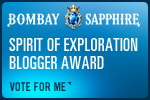Google Maps is one of the most useful tools I have found on the Internet. I have been using it for about three years for everything from figuring out the shortest driving routes for road trips to looking at satellite views of the pyramids of Egypt. But most of the time, I just use it to fantasize about the places where I would like to go. Even if I never visit them all, at least I've improved my understanding of geography.
Until today I never bothered to check out the My Maps feature. It allows users to create their own custom maps with points of interest, routes, photos, videos and other content, and then to share their maps with others. Of course, as a sailing dreamer, the first thing I did was to lay out a circumnavigation route--not the one I have been dreaming about lately, which will appear in future "Circumnavigation Routes" posts, but the one I came up with in 2001. Here is a link to it: Circumnavigation Route 2001.
Back when I was working for the Aspen School District, I had a giant National Geographic map of the world on the wall in my office and I would spend odd moments staring at it and figuring out where I would sail if I ever had the chance. Since it was pure fantasy, I wanted to sail absolutely everywhere, with the idea that I would never see some of the places if I didn't include them in one incredibly ambitious circumnavigation. So remote places in the Pacific Ocean, like the Galapagos Islands, Robinson Crusoe Island, Easter Island, and Pitcairn Island from Mutiny on the Bounty fame were naturally on the list, as were most of the Mediterranean port cities of Europe. I had recently finished climbing all of Colorado's 14,000-foot peaks and was looking for new climbing challenges, so the four peaks of the Seven Summits (the highest peaks on each of the seven continents) that I would encounter along the way--Cerro Aconcagua, Mount Kosciuszko, Mount Kilimanjaro and Mount Elbrus--were also on the list. Since my parents own a vacation home near the ocean in Savannah, Georgia, that was my logical starting and ending location.
The circumference of the earth is about 25,000 miles but according to Google Maps, my "Around the World" route would be a little more than twice that distance. That's an awful lot of deviation from the shortest possible distance, and it doesn't even remotely take into account the prevailing winds or weather conditions, which I knew little about when I was planning it all out. I have studied other circumnavigators' routes, from Joshua Slocum's to Robin Lee Graham's, and they seem to average about 35,000 miles and take about five years. Applying the math, my route, if it was not impossible to complete, would take at least seven years. But most of those other voyages were continuous, with quick landfalls for reprovisioning. What if we decided to spend a year in France? That is why I think of this dream, as I have mentioned in previous "Circumnavigation Routes" posts, as a for-the-rest-of-my-life experience rather than as just another accomplishment to be checked off the "life list." As they say, the journey is the reward.
This blog is an account of the pursuit of a dream, to sail around the world. It is named after the sailboat that will fulfill that dream one day, Whispering Jesse. If you share the dream, please join me and we'll take the journey together.
For Charlie and Scout
For Charlie and Scout
About Me

- John Lichty
- Savannah,
Georgia, USA
"Go confidently in the direction of your dreams. Live the life you have imagined." --Henry David Thoreau
 Raising Charlie: The Lessons of a Perfect Dog by John Lichty
Raising Charlie: The Lessons of a Perfect Dog by John Lichty
Blog Archive
Followers

Recommended Links
- ATN Sailing Equipment
- ActiveCaptain
- BoatU.S.
- Coconut Grove Sailing Club
- Doyle Sails - Fort Lauderdale
- El Milagro Marina
- John Kretschmer Sailing
- John Vigor's Blog
- Leap Notes
- Noonsite.com
- Notes From Paradise
- Pam Wall, Cruising Consultant
- Practical Sailor
- Project Bluesphere
- Sail Makai
- So Many Beaches
- Windfinder
Sunday, January 4, 2009
Subscribe to:
Post Comments (Atom)




1 comment:
great! Just what I need as I'm about to quit my job and go independent -- another great way to waste time on the internet and daydream.
Post a Comment